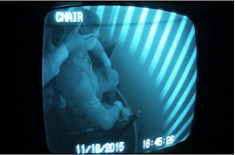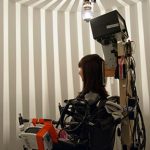- What are you going to expect during the treatment? We will use the procedures described in our open access paper (Readaptation of the Vestibulo-Ocular Reflex Relieves the Mal de Debarquement Syndrome. 2014, http://www.ncbi.nlm.nih.gov/pmc/articles/PMC4097942/). On the first day, we will measure your postural motion and characteristics of your rocking/swaying with a Wii balance board (A) and a 3D accelerometer attached to your wrist (B), which is used to let you move your arm to mimic the internal sensation of motion. We will also examine your nystagmus in darkness using videooculography and your body drifting during Fukuda stepping test. We will use these findings to determine the specific treatments for you.
Next, you will be seated in a chair in a round enclosure (image: left) watching moving black & white stripes while your head will be slightly rolled or rocked by a therapist (image: right) with a pace (frequency) set by audible cues ( metronome). This will be done for a few minutes at a time (a session), and you will be treated/tested for several sessions in 1 -2 hours for a day visit.
- Should I take a Benzodiazepine medication (Valium or Klonopin or others) for traveling back home ? Yes, it is recommended although it will not guarantee that it will work against a reversion. You should request a prescription from your physician at home prior to your arrival.
- I have been on Benzo for dizziness, anxiety and insomnia, should I taper off it before coming for treatment? It is better not to have taken any Benzos a week or two before the treatment. Consult your physician on how to wean off Benzos properly to avoid withdrawal symptoms. NEVER STOP TAKING BENZOS ABRUPTLY. If you cannot wean off it for various reasons, you may continue the medication or consult with your physician for alternatives. You may continue on selective serotonin reuptake inhibitors (SSRIs), selective norepinephrine reuptake inhibitors (SNRIs), and antidepressants. You also can take your migraine medications.
- Can I take a train or car ride to your lab? Yes. But if your travel time is more than an hour, you have to wait at least an hour prior to the scheduled time to wash out the traveling effects.
- What is the rate of success? We define Success of treatment by a reduction of overall symptoms by more than 50%. After 4 – 5 days of treatment, current the rate of success for classic MdDS is better than 75% and for spontaneous MdDS is about 50%, measured immediately after the completion of treatment. Data on one year follow-up has been punished on an open assess journal, Frontiers in Neurology (2017): http://journal.frontiersin.org/article/10.3389/fneur.2017.00175/full.
- Is there a home treatment program available? Yes. During the treatment in our lab, we will determine the best paradigms that have helped you the most. We will provide you with specific instructions if the home treatment is necessary when you return home. The home treatment is individually tailored based on the results of lab treatments. Doing the home treatment without our consultation will likely cause adverse effects on you.
- Would the treatment make my symptoms worse? Yes, but temporarily, due to the occurrence of migraines triggered by visual stimulus. This is rarely happening as we are monitoring your symptoms closely and beginning the treatment using minimal visual stimulus. The headache/head pressure, heaviness of the body and nausea that are part of your symptoms or induced during the treatment is reversible with lab interventions.
- Any new development since the commencement of the treatment? Yes. We have been gaining more experience with MdDS since the treatment started 4 years ago. We are treating specific symptoms that you have. Not every MdDS patient has the same symptoms. The new protocols are developing to target gravity pulling, headache and head pressure, motion sickness, visual sensitivity, heavy body, circular rocking, shaking, trampoline walking (moon, penguin or rock walking).
- Can I go boating again after I am getting better? No. The treatment we provide is not for preventing a relapse of MdDS. It is not safe to be in or on natural waters such as ocean, rivers, lakes or even ponds, not even to swim in ocean or river. Swimming in a pool is Okay as long as you are not spending time on a floating device (i.e., raft). MdDS is different for each patient, so walking on beach is OK for some but not for others. Avoid virtual reality and driving simulator experiences. If you are still experiencing symptoms, it is recommended not to walk on a treadmill and to use an elliptical machine.



